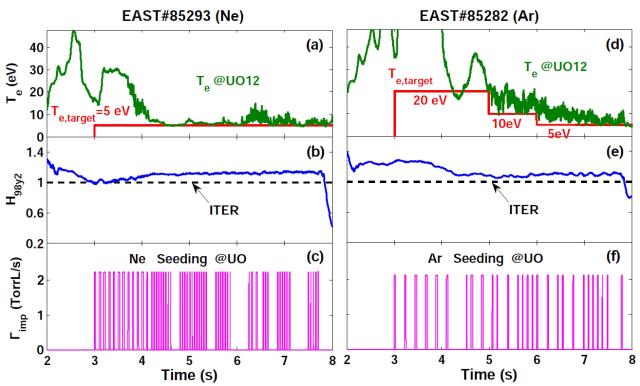Speaker
Description
Joint research on the tokamaks DIII-D and EAST demonstrates a successful integration control of divertor detachment with excellent core plasma performance, a milestone towards solving the critical Plasma-wall-interaction (PWI) issues for ITER and future reactors. DIII-D has achieved actively controlled fully detached divertor with low plasma temperature ($T_{e,div} \le $ 5 eV across the entire divertor target), low particle flux (DoD > 3) and heat flux reduction > 85%, simultaneous with very high core performance ($\beta_N$ ~ 3, $\beta_P$ > 2 and $H_{98}$ ~ 1.5) in the high $\beta_p$ scenario developed for ITER steady state operation. EAST has achieved actively controlled detachment with $T_{e,div}$ ~ 5 eV and $H_{98} \ge$ 1.1 in various H-modes, i.e., normal ELMy H-mode, grassy ELMy H-mode and high $\beta_P$ H-mode scenarios. The divertor detachment with $T_{e,div} \le $ 5 eV is highly desirable for suppression of the erosion in reactor-grade devices.
In DIII-D, full detachment was achieved, for the first time, with very high $H_{98}$ ~ 1.5 by utilizing feedback controlled impurity seeding in the high $\beta_P$ scenario $[1]$. The self-organized with co-existence of internal transport barrier (ITB) and edge transport barrier (ETB, or pedestal) benefits access to detachment without degradation of core performance. The scenario makes detachment easier by optimizing impurity seeding at relatively higher $q_{95}$ and lower separatrix density, with very high core confinement enabled by a large-radius ITB. Fig. 1 shows a fully detached plasma with excellent core confinement in the high $\beta_P$ scenario on DIII-D with nitrogen seeding. In the full detachment phase, the steady-state peak heat flux measured by infra-red (IR) camera is reduced by > 85%, and the particle flux measured by divertor Langmuir probes is reduced by > 80%. Nitrogen seeding is more efficient for full detachment than neon-seeding experiments and leads to a small reduction of ETB. The demonstration of compatibility with divertor detachment adds to the well-known benefits of high bootstrap current fraction and low disruption risks, positioning the high $\beta_P$ scenario as a prime candidate for steady-state fusion reactor operation. 
In EAST, actively feedback controlled H-mode detachment with simultaneous $T_{e,div}$ ~ 5 eV and $H_{98}$ > 1.1 was achieved using either divertor neon or argon seeding in USN configuration, i.e. divertor detachment operating on an ITER-like tungsten divertor, was maintained with energy confinement quality higher than the ITER baseline scenario, as shown in Fig. 2. The feedback detachment waveforms follow closely the preset targets. Experiments using injection of different impurity species for radiative divertor and detachment were performed to understand the extrapolation to future burning plasmas on ITER and CFETR. Neon exhibits good core-divertor integration, while argon is more efficient for detachment with a slight loss of confinement. In addition, different detachment feedback controllers including degree of detachment (DoD) via Langmuir probe measured divertor particle flux $[2]$, divertor $T_{e,div}$ $[3]$, plasma radiative power $P_{rad}$ $[4]$, $T_{e,div}$ + $P_{rad}$ have all been developed successfully in EAST. 
The success of actively controlled detachment is achieved with different divertors and benefits from the divertor closure and pumping. A closed divertor is beneficial for neutral trapping and thus detachment access $[5-6]$, as well as the drift effect in the SOL and divertor volume. Furthermore, the sustained detachment compatible with core high performance is independent of plasma heating schemes and divertor materials, i.e., EAST with ITER-like tungsten wall + RF heating and DIII-D with carbon wall + NBI heating, respectively.
The compatibility of efficient divertor detachment with a high-performance core is vital to the realization of magnetically controlled fusion energy. The significant progress in DIII-D and EAST show that the potential for a high-performance core plasma suitable for long pulse operation of fusion reactors can be achieved with controlled PWI. The present joint DIII-D/EAST methodology will be used for minute-time-scale long pulse operation on EAST in near future and thus offers a useful solution for ITER, CFETR as well as future fusion energy power plants.
This work was supported by National Key R&D Program of China under 2017YFE0301300 and the U.S. DOE under DE-FC02-04ER54698, DE-AC04-94AL85000, DE-NA0003525, DE-AC52-07NA27344.
$[1]$ L. Wang, H. Q. Wang$^*$, A. M. Garofalo et al, “First Observation of Fully Detached Divertor Compatible with Improved Core Confinement in Tokamak”, to be submitted to PRL
$[2]$ L. Wang$^*$ et al., Nucl. Fusion 59, 086036 (2019)
$[3]$ D. Eldon, …, L. Wang et al., this conference (Poster submission)
$[4]$ K. Wu, …, L. Wang$^*$ et al., Nucl. Fusion 58, 056019 (2018)
$[5]$ J. B. Liu, L. Wang$^*$ et al., Nucl. Fusion 59, 126046 (2019)
$[6]$ X. J. Liu, L. Wang$^*$ et al., Phys. Plasmas 16, 102510 (2019)
Disclaimer: This report was prepared as an account of work sponsored by an agency of the United States Government. Neither the United States Government nor any agency thereof, nor any of their employees, makes any warranty, express or implied, or assumes any legal liability or responsibility for the accuracy, completeness, or usefulness of any information, apparatus, product, or process disclosed, or represents that its use would not infringe privately owned rights. Reference herein to any specific commercial product, process, or service by trade name, trademark, manufacturer, or otherwise does not necessarily constitute or imply its endorsement, recommendation, or favoring by the United States Government or any agency thereof. The views and opinions of authors expressed herein do not necessarily state or reflect those of the United States Government or any agency thereof.
| Affiliation | Institute of Plasma Physics, Chinese Academy of Sciences |
|---|---|
| Country or International Organization | China |
